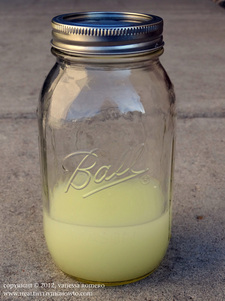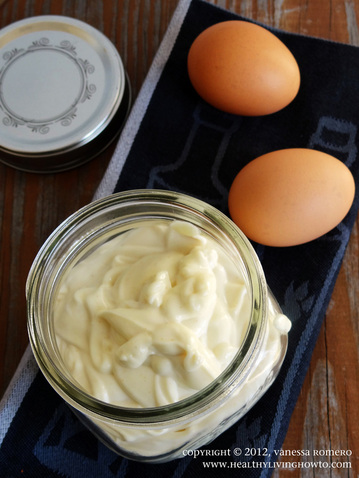There are two methods of lacto-fermentation, one uses whey and the other uses salt. Both produce excellent results however, the method of fermentation you choose, depends on what it is you are actually fermenting. Whey is essential when fermenting fruit as well as condiments like salsa, ketchup, mustard and mayonnaise. Salt fermentation is the method of choice when fermenting pickles, cabbage, peppers, green beans and carrots.
The lacto-fermentation process using whey, has been popularized by the book Nourishing Traditions by Sally Fallon. Whey refers to the liquid remaining from milk or yogurt after it has been strained to make cheese. According to Christopher Vasey, N.D. whey has four main healing properties, it regenerates intestinal flora, eliminates fluid retention, stimulates the kidneys to release toxins and stimulates intestinal peristalsis.
 Whey Used for Lacto-Fermentation
Whey Used for Lacto-Fermentation
Making your own whey is quite simple and is a wonderful healing practice you can implement in your kitchen. Whey is a healing tonic that can be added to just about anything, but hides especially well in condiments. In addition to making mayonnaise with whey, I like to sneak some into a pitcher of iced green tea on occasion.
This is a quick and easy method for making your own whey as well as yogurt cheese. A word of caution, the yogurt cheese will be a very concentrated source of casein, the most common culprit in dairy sensitivities.
You want to start with one quart of high quality plain yogurt from grass-fed cows. No fillers or sweeteners. Place the yogurt in a strainer lined with cheese cloth or a clean linen dish towel, placed over a bowl. Cover with a plate and leave at room temperature overnight. You can coax more whey out of the yogurt with gravity if you'd like, by first tying the cloth up and then tying it to a wooden spoon. You will then suspend across a bowl or pitcher. What results is about a cup or so of whey that can now be used in lacto-fermentation.
Store the whey in a Mason jar and yogurt cheese in a covered glass container. Refrigerated, the yogurt cheese will keep for about 1 month and the whey for about 6 months. However, it won't last that long if you sneak it into foods you are already eating. I'll start you off with a healthy recipe for lacto-fermented mayonnaise that tastes better than anything you can buy off the shelf and is not even on the same spectrum when it comes to comparing health benefits.
Prep Time: 5 minutes
Makes: 1 cup
Ingredients
- 1 Large Pasture Raised Egg
- Dash Cayenne Pepper
- 1/2 tsp. Organic Dry Mustard
- 1/4 tsp. Celtic Sea Salt
- 2 Tbsp. Coconut Secret Raw Coconut Vinegar
- 1/4 c. Extra Virgin Olive Oil
- 3/4 c. Spectrum Naturals Organic High Heat Sunflower Oil
- 7 drops NuNaturals Pure Liquid Clear Stevia (optional)
- 1 1/2 tsp. Whey
Directions
- Combine the egg, cayenne, mustard, salt, vinegar, stevia, whey and 1/4 c. oil in the container of a blender or food processor.
- With the machine running, add the remaining oil in a thin, constant, steady stream.
- After you've added about half the oil, the mixture should start to thicken.
- Once all the oil has been incorporated, shut off the machine and transfer mayonnaise to a small Mason jar and close the lid tightly.
- Leave the mayo on the counter for 7-12 hours to “ferment” and then refrigerate.
Other Oil Options
You can use all olive oil if that's your thing, but be sure to use an olive oil you like the taste of. To be perfectly honest, I am not a huge fan of the taste of extra virgin olive oil and use light olive oil instead, even though it's refined. “High-heat”, also called “high-oleic”, sunflower oil, is named such, due to its high concentration of oleic acid, the same monounsaturated fat found in olive oil. It has virtually no taste which makes if perfect for making mayonnaise. For a really decadent tasting mayo try using macadamia nut oil.
Recipe Notes
All ingredients should be at room temperature. Assuming the only ingredients you keep in your refrigerator are the egg and whey, simply take them out a few hours before you plan to make the mayo. I use coconut vinegar in this recipe for it has amazing health benefits, however, you can certainly use another vinegar. Some recipes call for lemon juice, and I am finding I prefer mayo without it. Personal preference.
Finally, you don't have to lacto-ferment this mayonnaise. It will be still be much healthier than store-bought mayo. However, it will only last for about a week in the refrigerator. On the other hand, lacto-fermented mayo will last about 6-8 weeks or longer, don't worry it will be long gone before it goes bad.
Update
Since finding out I have IgG-mediated allergies to casein and whey, I have used the liquid from the sauerkraut to ferment my mayonnaise. Works like a charm.


